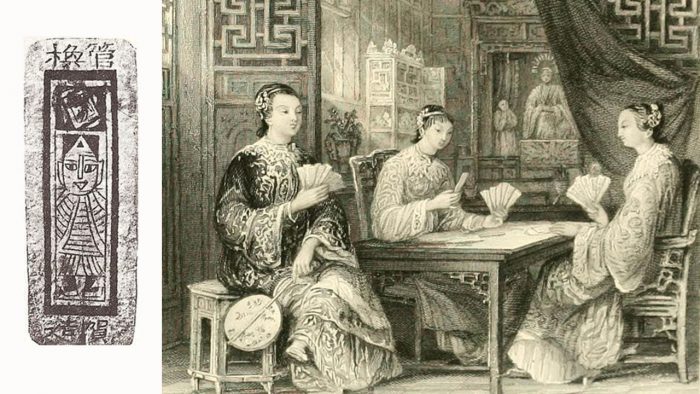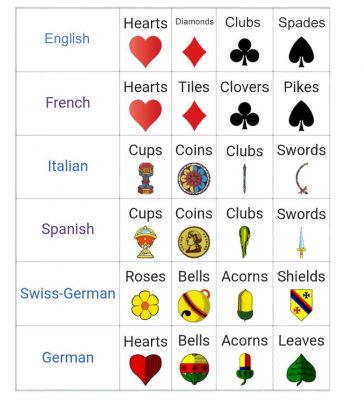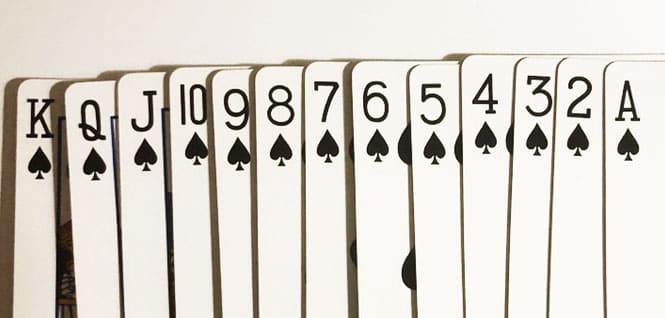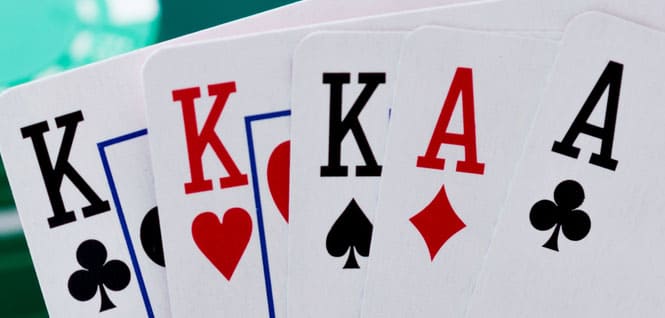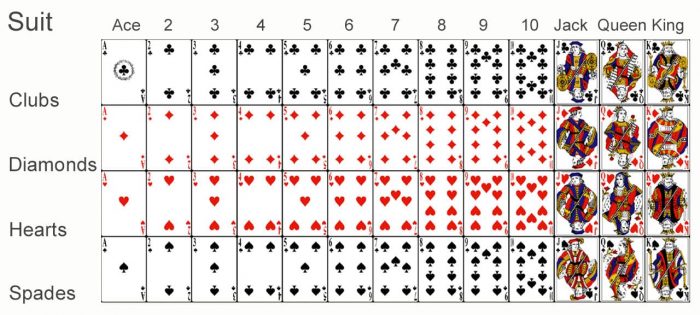Each of us knows what playing cards are and many of us have played them. But has anyone ever wondered how, when, and why the first cards and the suits depicted on them appeared?
Whatever deck you play, no matter how ancient or modern it may be, the card suits remain the same. Even a child can draw them. But why are there four suits and not five? And why are the suits colored red and black?
The history of playing cards can be traced back to the 9th century, which is the earliest known time when such a game was invented in China. Not long before that, the Chinese had begun to use separate sheets of paper for writing instead of long scrolls. Their playing cards were also paper rectangles. The deck consisted of cards of four suits: coins, laced coins (in ancient China, coins had holes to be worn on a string), myriads (that is, 10,000 coins), and tens of myriads.
The game came to Europe around the middle of the 14th century, apparently through Egypt. Particularly widespread cards were in the 15th century, then they were already produced on an industrial level, by applying the image stencil.
Already in the second half of the 15th century, a craftsman from Rouen invented cards which are similar in symbolism to modern card products. Perhaps the meanings of these symbols have survived to this day: hearts, hearts meant the church, rhombuses meant merchants. But the other suit had a different look – it was drawn in the form of red signs. Spades were painted black or arrowheads, which symbolized power, the state. Clubs (crosses) practically unchanged, they denote three-leaf clover, which symbolizes the farmer, a simple countryman.
Thus, all four of these suits had their semantic clue, representing: finance, spiritual values, agriculture, the state, and peaceful settlement.
Card suits already then were similar to the current, but their names and images varied from country to country. In Germany, for example, established a heart, bells (bells), acorns, and leaves, in Italy – cups, coins, rods, and swords. Widespread cards with hearts, diamonds, clubs, and spades first appeared in France.
Card games, how they appeal to lovers of excitement, these paper cards, and the sea of extreme getting out of them. And in the past, card games were available only to men of noble birth. But with the development of civilization gradually all the benefits are becoming public.
The symbolism of the cards and suits was reborn andchanged many times. Some associated the images depicted on the playing cards with religious deities, others with political figures, famous warriors, and wars. Whatever version you like most, one thing is impossible to argue with — today card suit symbols are one of the most famous graphical icons, which do not have a second meaning. Though it’s interesting, that the most famous casinos do not use any of the suits for their logos.
The card suits also once carried a deep meaning that has gradually been forgotten. To remember it, you need to turn to the ancient Indian version of the game. These cards were called ganja and were round. They depicted the figure of four-armed Shiva, who was holding a cup, sword, coin, and rod. Most likely, these symbols of the four Indian estates and gave rise to the modern card suits.
In Europe, swords became “spades,” cups became “hearts,” coins became “diamonds,” and clubs became “clubs. But even in the later tradition, the suits still corresponded to the four main feudal classes: military, clergy, merchants, and peasantry. These names sound differently in different languages. For example, in England and Germany, they are spades, hearts, diamonds, and clubs, while in Italy they are spears, hearts, squares, and flowers. On German maps, you can still find the ancient names of the suits: acorns, hearts, bells, and leaves.
The card suits are very strong symbols, which are very difficult to associate with anything else but the card games. Neither spades, diamonds, clubs, or even hearts are used as typical logo symbols, as they are strongly connected to their initial meanings.
Interestingly, there is another, occult interpretation of card suits, it is given as an example when for religious reasons are forbidden to play cards. In this interpretation, “crosses” symbolize the cross on which Jesus was crucified, “spades” – spear of the holy martyr Longinus, “hearts” means the evangelical sponge on a stick, with which the crucified were drunk, and “diamonds” – square nails, pierced the legs and arms of the Savior.
So, in any deck, the cards are differentiated by rank “higher” and “lower” or “higher” and “lower. For each rank, there is only one card in each suit. Only the number of cards in the row of each suit changes. For example, in Italy and Spain, there are 10, in some games in Germany and Austria – 8, in the most popular deck – French – 13. This is what is used in poker.
As for the hierarchy of the suits, there is no universal seniority of suits in the variety of card games, so many games have their scale: for example, in bridge, there is a hierarchy – spades, hearts, diamonds, and clubs. For this reason, games are organized in such an order that would regulate the location and, so to speak, the strength of suits.
In poker, such a ranking is used quite rarely, though this is not to say, that suits don’t mean anything. Some of the strongest poker hand combos such as flush and flush royal are formed by cards of the same suit. At the same time, most hands are based on poker card names, like Ace-Ace or King-Three. But there sometimes can be out-of-game disputable situations, where the suits are used for solving: determining seats at the table or splitting the pot. In this case, the seniority of suits in poker is the following: spades, hearts, diamonds, and clubs.
We already found out that the four suits are thought to denote the four estates on which the state was held at the time: the clergy, merchants, peasants, and the military. Mystics of the same years add in their writings that four is the magic number, there are four elements in the world, four seasons, four squares of the signs of the Zodiac, four periods, and so on.
Let’s have a look at the mystical interpretation of the suits of the cards’ meaning. Together the four suits of playing cards represent the four elements — the earth, the winds, the seasons, and the lands of the world. The thirteen cards of each suit represent the thirteen lunar months. The whole card deck forms a detailed allegory of the universe. In a collective sense, the cards represent a life – with all its joys and sorrows – and the struggle of opposing forces to defeat one another. Fifty-two playing cards together represent each day of the year.
Spades, like the black clubs, represent the cold season – autumn and winter, as well as the power of darkness. Their symbol – trefoil – means life.
Clubs are a black suit; like spades, they represent autumn, winter, night, and darkness. As opposed to diamonds, clubs are a symbol of masculinity.
The diamond suit symbolizes the warm, bright seasons and represents femininity.
Along with the other red suit, diamonds, hearts symbolize the warm seasons, spring and summer, and signify the forces of light. Hearts are the sign of the center of both life and peace.



